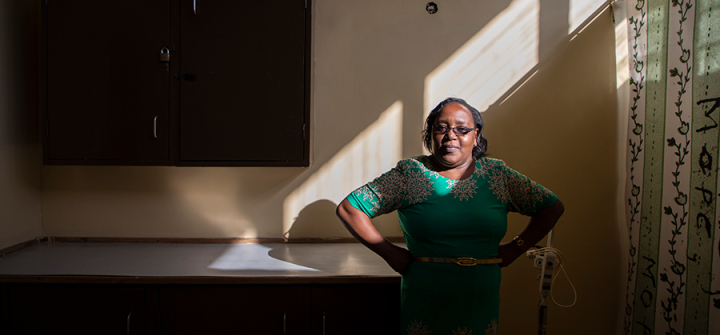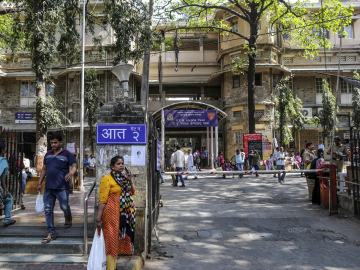The Muranga Solution: Extending Hemophilia Care to Rural Kenya
MURANGA, KENYA – Jane Mugasha only learned about hemophilia 8 years ago after nearly losing a patient who had come to her hospital for a routine circumcision.
“When we tried to dress the wound, the boy would keep on bleeding and bleeding and we did not know what to do,” said Mugasha, then a pediatric nurse at Muranga hospital in central Kenya.
After the boy kept bleeding and grew weak despite several blood transfusions, the hospital staff sent him in an ambulance to Kenyatta National Hospital about 2 hours away in the capital Nairobi. At KNH, the main referral hospital for East Africa, a team managed to stop his bleeding, much to Mugasha’s relief. Back in Muranga, she did her research and learned about hemophilia. She had the answer to what had nearly killed the child, but she didn’t have a solution.
The medications needed stop bleeding in hemophilia patients—called factor concentrates—was not available at her hospital, she said.
It was only after a later visit by Jose Memorial Haemophilia Society representatives that Muranga hospital began to get factor for the hospital. Even then, JMHS was only able to provide 3 vials every 2-3 months allowing Mugasha and others to treat only the most severe cases.
Since then, Mugasha has gone on to become the coordinator of hemophilia services for the vast Mount Kenya region. In October, Mugasha realized a longtime dream of launching a dedicated hemophilia center at Muranga hospital. “It is my prayer answered,” she said. The clinic opened with the help of the Novo Nordisk Hemophilia Foundation, which invests in better training and facilities for hemophilia patients in countries like Kenya, where services are limited. The Muranga clinic already has more than 60 patients—this in a country with only 450 people have been diagnosed and registered with hemophilia. An estimated 5,000 Kenyans have the blood disorder.

Hesborn Ndirangu, 8, sits outside the newly established Haemophilia Care Clinic at the Muranga Dis-trict Hospital in Muranga County, Kenya. Image: Will Swanson for GHN
Aside from the Nairobi clinic at KNH, the only other hemophilia treatment centers are in the southern port city Mombasa and the western city of Eldoret. In a large country like Kenya, this means that patients could travel for hours to get treatment—or days for people living in the immense territory north of Nairobi.
For 28-year-old Virginia Muthoni, having the Muranga clinic on their doorstep has been a huge relief. Her 10-year-old son Erik has severe hemophilia. For the past 7 years since he was diagnosed, the single mother has had to rush him numerous times to KNH in Nairobi. She wants to ensure Erik does not suffer the same fate as her father who had hemophilia. He died at age 32 from a stomach injury as his family tried to raise money for bus fare to get him to Nairobi for treatment.
Through NNHF, Mugasha attended workshops on hemophilia care, including some in South Africa—which is 1 of 2 sub-Saharan countries that has made significant progress in diagnosing and treating patients for free. (The other is Mauritius.) Mugasha has taught staff at her hospital and recently, more than 70 health workers who came from health facilities across the region. She taught them how to recognize and treat hemophilia using factor or transfusing with blood. When neither is available, she also instructed them on using ice, compression and elevation.
Without proper, timely treatment or physiotherapy, hemophilia can cause blood to swell joints and lead to severe pain. “Most of them are limping, and especially those of 20 years and above, when there was no factor,” said Mugasha. “Now we are planning to start giving treatment at an early age, as early as below 1 year, so you’re able to manage those joints easily and deformity will be a thing of the past,” she said.
8-year-old Hesborn Ndirangu came to the Muranga clinic in mid-November from nearby Nyeri after his family saw a television report about the clinic. His puffed knees from weeks-old bleeds mean he hobbles and swings one leg to walk. “It hurts a bit. It usually heals with medicine,” he said.
While Hesborn’s mother goes door to door taking on small jobs like washing and earns $1-2 per day, his grandmother Beatrice would often takes him to KNH. Sometimes, they would have to stay overnight because it would be too late to leave Nairobi for Muranga. Traveling to the clinic in Muranga costs $5 instead of $10 for them to get to Nairobi so it’s much preferable, but the medicine he needs isn’t always available.
“Whenever we have some few [vials], within a short time it is over,” said Mugasha. The shortages do not stop her from doing outreach to find more people with hemophilia and tell them that it is a treatable medical condition and to dispel common myths about it being linked to witchcraft.
Nor does it stop Mugasha from training health workers to learn how to help hemophilia patients, as well as patients, parents and other family members. Educating health workers beyond the 4 public hospitals with hemophilia clinics saves people the financial and emotional stress of travelling extreme distances. Hospital staff can send factor by bus or motorbike taxi to patients’ local health facilities or even their homes. People can be coached over the phone through the process of injecting or infusing factor. Even in Nairobi, doctors send factor to patients who cannot reach the hospital when there are chronic traffic jams or when they have no one to accompany them.

Muna Faize with her son Asad at the Kenyatta National Hospital in Nairobi, Kenya. Image by Will Swanson
Having factor nearer her home is Muna Faize’s dream. Once every couple weeks and sometimes once a week, when her 17-month-old son Assad has a small bump or cut, she and her husband have to find $150 in bus fares and travel 800 kilometers from their home in Moyale in northern Kenya to KNH. They have to leave at 3 p.m. and arrive the next morning at 8 a.m to get to the clinic for morning opening.
“Last week he had some cut in his mouth and he bled [until] I got him here,” she said.
The family sometimes spends weeks away from home, squeezed into the homes of friends and relatives in Nairobi, until it is safe to take baby Assad home. On a couple of occasions, Faize has managed to find clotting factor nearer Moyale and people to help pay for it—the medicine to treat Assad has cost $600.
“Sometimes he plays, but I have a difficult time to watch him and to prevent him from bad things like falling down and bruising,” said Faize, who has 2 brothers with hemophilia who were relocated from Kenya to Canada by the UN to get the treatment they needed.
Mugasha hopes to extend the reach of hemophilia treatment to help people like Assad via satellite clinics and other means.
“We have started doing home visits, started counselling parents and patients who do not accept hemophilia,” she said. “We are able to tell them now it is not a curse but a condition that can be managed by using factor.”
Read the entire GHN series “‘We are Many’: The Race to Treat Hemophilia in Kenya” here.
Join the tens of thousands of subscribers who rely on Global Health NOW summaries and exclusive articles for the latest public health news. Sign up for our free weekday enewsletter, and please share the link with friends and colleagues: http://www.globalhealthnow.org/subscribe.html
Jane Mugasha coordinates hemophilia services for the Mount Kenya region. Image: Will Swanson for GHN




